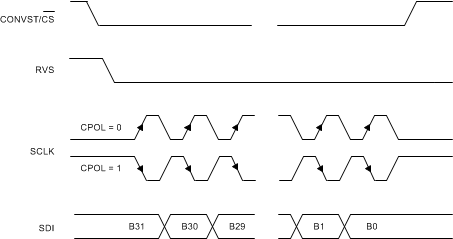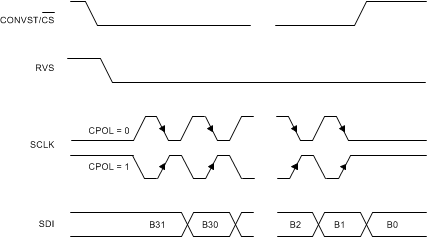SBASAY5 June 2024 ADS8681W
PRODUCTION DATA
- 1
- 1 Features
- 2 Applications
- 3 Description
- 4 Pin Configuration and Functions
- 5 Specifications
-
6 Detailed Description
- 6.1 Overview
- 6.2 Functional Block Diagram
- 6.3 Feature Description
- 6.4 Device Functional Modes
- 6.5 Programming
-
7 Register Maps
- 7.1
Device Configuration and Register Maps
- 7.1.1 DEVICE_ID_REG Register (address = 00h)
- 7.1.2 RST_PWRCTL_REG Register (address = 04h)
- 7.1.3 SDI_CTL_REG Register (address = 08h)
- 7.1.4 SDO_CTL_REG Register (address = 0Ch)
- 7.1.5 DATAOUT_CTL_REG Register (address = 10h)
- 7.1.6 RANGE_SEL_REG Register (address = 14h)
- 7.1.7 ALARM_REG Register (address = 20h)
- 7.1.8 ALARM_H_TH_REG Register (address = 24h)
- 7.1.9 ALARM_L_TH_REG Register (address = 28h)
- 7.1
Device Configuration and Register Maps
- 8 Application and Implementation
- 9 Device and Documentation Support
- 10Revision History
- 11Mechanical, Packaging, and Orderable Information
Package Options
Mechanical Data (Package|Pins)
- RUM|16
Thermal pad, mechanical data (Package|Pins)
- RUM|16
Orderable Information
6.5.4.1 Protocols for Configuring the Device
As described in Table 6-8, the host controller uses any of the four legacy, SPI-compatible protocols to write data into the device. These protocols are SPI-00-S, SPI-01-S, SPI-10-S, or SPI-11-S.
| PROTOCOL | SCLK POLARITY (At CS Falling Edge) | SCLK PHASE (Capture Edge) | SDI_CTL_REG | SDO_CTL_REG | DIAGRAM |
|---|---|---|---|---|---|
| SPI-00-S | Low | Rising | 00h | 00h | Figure 6-26 |
| SPI-01-S | Low | Falling | 01h | 00h | Figure 6-26 |
| SPI-10-S | High | Falling | 02h | 00h | Figure 6-27 |
| SPI-11-S | High | Rising | 03h | 00h | Figure 6-27 |
On power-up or after coming out of any asynchronous reset, the device supports the SPI-00-S protocol for data read and data write operations. To select a different SPI-compatible protocol, program the SDI_MODE[1:0] bits in the SDI_CNTL_REG register. This first write operation adheres to the SPI-00-S protocol. Any subsequent data transfer frames adhere to the newly-selected protocol. The SPI protocol selected by the configuration of the SDI_MODE[1:0] is applicable to both read and write operations.
Figure 6-26 and Figure 6-27 detail the four protocols using an optimal data frame; see the Timing Requirements table for associated timing parameters.
A valid write operation to the device requires a minimum of 32 SCLKs to be provided within a data transfer frame. See the Data Transfer Frame section for details.

